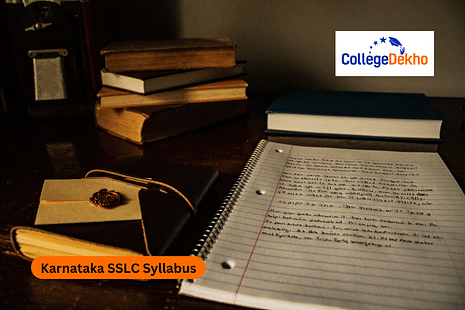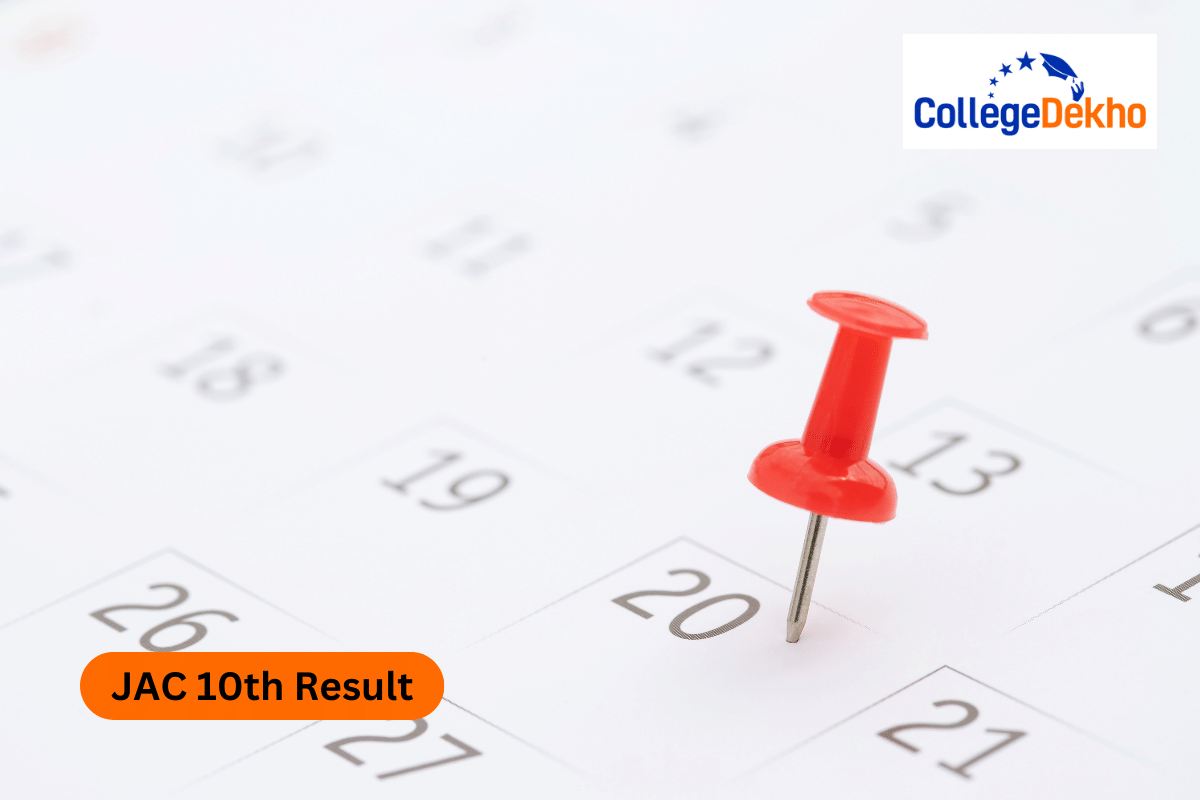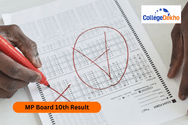Karnataka SSLC Syllabus 2024-25 will help you students to effectively prepare for the exam. The syllabus will include the names of the units and chapters included in the curriculum.
- About Karnataka SSLC Syllabus 2024-25
- Karnataka SSLC Latest Updates 2025
- Karnataka SSLC Syllabus 2024-25 Download PDF
- Karnataka SSLC Syllabus 2024-25 for Science
- Karnataka SSLC Syllabus 2024-25 for Mathematics
- Karnataka SSLC Syllabus for Social Science
- Karnataka SSLC Syllabus for English
- Karnataka SSLC Exam Pattern 2024-25
- Karnataka SSLC Preparation Tips 2025
- Benefits of Knowing the Karnataka SSLC Syllabus 2024-25
- Karnataka SSLC Important Books 2025
- Faqs


Never Miss an Exam Update
About Karnataka SSLC Syllabus 2024-25
Karnataka School Examination and Assessment Board will upload the official PDF of the syllabus on their website. The syllabus will include information about the topics and chapters included in the curriculum. 100 marks will be provided to all the subjects included in the curriculum. There are 6 languages and 6 non-language subjects included in the curriculum. 100 marks will be divided between theory and practical exams. The theory exam will be conducted for 80 marks and the practical exam will be conducted for 20 marks for most of the subjects.
The three core subjects included in the Karnataka SSLC syllabus ie Mathematics, Science, and Social Science. Students are also advised to go through the Karnataka Class 10 Exam Pattern 2024-25 to understand the marking scheme and division of marks between internal assessment and theory exams. They can check the complete Karnataka Board Class 10 Syllabus 2024 for all the subjects from here.
Also Read: Karnataka SSLC Result 2025
Karnataka SSLC Latest Updates 2025
- March 13, 2025: Karnataka SSLC exam 2025 will begin from March 21 with the First Language papers and will conclude on April 4, 2025 with the Third Language papers.
- March 13, 2025: The Karnataka School Examinations and Assessments Board, KSEAB will release the Karnataka SSLC Result 2025 on May 9, 2025 tentatively as per last year's trend.
Karnataka SSLC Syllabus 2024-25 Download PDF
Right now, the Karnataka SSLC syllabus for the year 2025 is not available on the official website so given below we are sharing the previous year's Karnataka SSLC Syllabus PDFs:
Subjects | Syllabus PDF |
|---|---|
Science | |
Social Science | |
Mathematics | |
English |
Karnataka SSLC Syllabus 2024-25 for Science
To prepare for the science paper, you can check out the Karnataka SSLC Science Syllabus 2024-25 from the table given below:
Chapter Name | Topics |
|---|---|
Chemical Reaction and Equations | Chemical equation, Balanced chemical equation, Implication of a balanced chemical equation, types of chemical reactions: combination, decomposition, displacement, double displacement, precipitation, neutralization, oxidation, and reduction. |
Acids, Bases and Salts | Their definitions in terms of furnishing of H+ AND OH- ions, General properties, examples, and uses, the concept of pH scale (Definition relating to logarithm not required), the importance of pH in everyday life; preparation and uses of Sodium Hydroxide, Bleaching powder, Baking soda, washing soda and Plaster of Paris. |
Metals and Non-metals | Properties of metals and non-metals; Reactivity series; Formation and properties of ionic compounds; Basic metallurgical processes; Corrosion and its prevention. |
Life Processes | ‘Living Being’. Basic concept of nutrition, respiration, transport, and excretion in plants and animals. |
Control and Coordination | Tropic movements in plants; Introduction of plant hormones; Control and coordination in animals; Nervous system; Voluntary, involuntary and reflex action; Chemical coordination; animal hormones. |
Electricity | Effects of Current Electric current, potential difference, and electric current. Ohm’s law; resistance, resistivity, factors on which the resistance of a conductor depends. Series combination of resistors, parallel combination of resistors, and its applications in daily life. Heating effect of electric current and its applications in daily life. Electric power, Interrelation between P, V, I, and R. |
Magnetic Effects of Electric Current | Magnetic field, field lines, field due to a current carrying conductor, field due to current carrying coil or solenoid; Force on a current carrying conductor, Fleming’s Left-hand rule, Electric motor, Electromagnetic induction. Induced potential difference, Induced current. Fleming’s right-hand rule, electric generator, direct current. Alternating current: frequency of AC. Advantage of AC over DC. Domestic electric current. |
Our Environment | Eco-system, environmental problems, ozone depletion, waste production, and their solutions. Biodegradable and non – biodegradable substances. |
Carbon and its Compounds | Tropic movements in plants; Introduction of plant hormones; Control and coordination in animals; Nervous system; Voluntary, involuntary, and reflex action; Chemical coordination; animal hormones. |
Periodic Classification of Elements | Need for classification, early attempts at classification of elements (Dobereiner’s Triads, Newland’s Law of Octaves, Mendeleev’s periodic table), Modern periodic table, gradation in properties, valency, atomic number, metallic and non-metallic properties. |
How do Organisms Reproduce | Reproduction in animals and plants (asexual and sexual) reproductive health needs and methods of family planning. Safe sex vs HIV/AIDS. Childbearing and women’s health. |
Heredity and Evolution | Heredity; Mendel’s contribution – Laws for inheritance of traits: Sex determination: brief introduction; Basic concepts of evolution. |
Light Reflection and Refraction | Natural phenomena Reflection of light by curves surfaces; Images formed by spherical mirrors, center of curvature, principal axis, principal focus, focal length, mirror formula (Derivation not required), magnification. Refraction; Laws of refraction, refractive index. Refraction of light by spherical lens; Image formed by spherical lenses; Lens formula (Derivation not required); Magnification. Power of a lens. |
The Human Eye and the Colourful World | Functioning of a lens in the human eye, defects of vision and their corrections, and applications of spherical mirrors and lenses. Refraction of light through a prism, dispersion of light, scattering of light, applications in daily life. |
Sources of Energy | Different forms of energy, conventional and non-conventional sources of energy: Fossil fuels, solar energy; biogas; wind, water, and tidal energy; Nuclear energy: Renewable versus non-renewable sources of energy. |
Sustainable Management of Natural Resources | Conservation and judicious use of natural resources. Forest and wildlife; Coal and Petroleum conservation. Examples of people’s participation in the conservation of natural resources. Big dams: advantages and limitations; alternatives, if any. Water harvesting. Sustainability of natural resources. |
Also Read: Karnataka SSLC Science Model Paper 2024-25
Karnataka SSLC Syllabus 2024-25 for Mathematics
Mathematics is a practice-based subject that requires logical thinking. It is a discipline that necessitates a strong grasp of many formulas and concepts. It is simple to get good grades if a student understands the hypothesis and concepts and continuously practices numerical tasks. The Karnataka SSLC Math Syllabus 2024-25 is listed below:
Topic | Details |
|---|---|
Arithmetic Progression | - Arithmetic progression derivation of the nth term and sum of the first n terms of A.P. and their application in solving daily life problems. |
Triangles | - Definitions, examples, and counterexamples of similar triangles |
Pair of linear equations in two variables | - Pair of linear equations in two variables and graphical method of their solution, consistency/inconsistency. Algebraic conditions for the number of solutions Solution of a pair of linear equations in two variables algebraically – by substitution, by elimination, and by cross multiplication method Simple situational problems. Simple problems on equations reducible to linear equations. |
Circles | - Tangent to a circle at, the point of contact (Prove) The tangent at any point of a circle is perpendicular to the radius through the point of contact (Prove) The lengths of tangents drawn from an external point to a circle are equal. |
Areas related to circles | - Motivate the area of a circle; area of sectors and segments of a circle. Problems based on areas and perimeter/circumference of the above-said plane figures. (In calculating the area of the segment of a circle, problems should be restricted to a central angle of 60°, 90°, and 120° only.) Plane figures involving triangles, simple quadrilaterals, and circles should be taken. |
Constructions | - Division of a line segment in a given ratio (internally) Tangents to a circle from a point outside it Construction of a triangle similar to a given triangle. |
Coordinate Geometry | - Review: Concepts of coordinate geometry, graphs of linear equations. Distance formula Section formula (internal division) Area of a triangle. |
Real Numbers | - Euclid’s division lemma, Fundamental Theorem of Arithmetic – statements after reviewing work done earlier and after illustrating and motivating through examples Proofs of the irrationality of the decimal representation of rational numbers in terms of terminating/non-terminating recurring decimals. |
Polynomials | - Zeros of a polynomial Relationship between zeros and coefficients of quadratic polynomials Statement and simple problems on division algorithm for polynomials with real coefficients. |
Quadratic equations | - Standard form of equation ax² + bx + c = 0, (a ≠ 0) Solutions of quadratic equations (only real roots) by factorization, by completing the square, and by using the quadratic formula Relationship between discriminant and nature of roots Situational problems based on quadratic equations related to day-to-day activities are to be incorporated. |
Introduction to Trigonometry | - Trigonometric ratios of an acute angle of a right-angled triangle. Proof of their existence (well-defined); motivate the ratios whichever are defined at 0 and 90. Values (with proof) of the trigonometric ratios of 30°, 45°, and 60° Relationships between the ratios. |
Some Applications of Trigonometry | - Proof and application of the identity sin²A + cos²A = 1 Only simple identities are to be given. Trigonometric ratios of complementary angles. |
Statistics | - Mean, Median, and Mode of grouped data (bimodal situation to be avoided) Cumulative frequency graph. |
Probability | - Classical definition of probability. Simple problems on single events (not using set notation). |
Surface areas and volumes | - Surface areas and volumes of a combination of any two of the following: cubes, cuboids, spheres, hemispheres, and right circular cylinders/cones. Frustum of a cone. Problems involving converting one type of metallic solid into another and other mixed problems. Problems with a combination of not more than two different solids to be taken. |
Also Read: Karnataka SSLC Math Previous Year Question Paper
Karnataka SSLC Syllabus for Social Science
It takes time to study social science. It is advised that students establish a study schedule by the SSLC timetable. Check out the following table for the key topics of the Karnataka SSLC Social Science Syllabus 2024-25 :
History
1. | The advent of Europeans to India |
|---|---|
2. | The Extension of the British Rules |
3. | The Impact of British Rule in India |
4. | Opposition to British Rule in Karnataka and Wodiyars of Mysore |
5. | Social and Religious Reformation Movements |
6. | The First War of Indian Independence (1857) |
7. | The Freedom Struggle |
8. | India After Independence |
9. | World war and India's role |
Political Science
10. | Challenges of India and their Remedies |
|---|---|
11. | India’s Relationship with Other Countries |
12. | World Challenges and India's role |
13. | World Organizations |
Sociology
14. | Social Stratification |
|---|---|
15. | Work and Economic Life |
16. | Collective Behaviour and Protests |
17. | Social Challenges |
Geography
18. | India: Geographical Position and Physical Features |
|---|---|
19. | India: Seasons |
20. | India: Soils |
21. | India: Forest Resources |
22. | India: Water Resources |
23. | India: Land Use and Agriculture |
24. | India: Mineral and Power Resources |
25. | India: Transport and Communication |
26. | India: Major Industries |
27. | India: Natural Disasters |
Economics
28. | Economy and Government |
|---|---|
29. | Rural Development |
30. | Public Finance and Budget |
Business Studies
31. | Bank Transactions |
|---|---|
32. | Entrepreneurship |
33. | Consumer Education and Protection |
Also Read: Karnataka SSLC Social Science Previous Year Question Paper
Karnataka SSLC Syllabus for English
One of the disciplines that can aid students in raising their percentage is English. The primary purpose of an English paper is to evaluate students' abilities in reading, writing, analyzing, and creativity. Check the Karnataka SSLC English Syllabus 2024-25 here:
- Reading Comprehension
- Noun
- Punctuation
- Articles
- Verb
- Adjective
- Prepositions
- Tenses
- Conjunction
- Sentences
- Vocabulary
- Transformation of Sentences
- Writing
Karnataka SSLC Exam Pattern 2024-25
There are 3 language papers and a total of 6 subjects for the Karnataka Class 10 exam. Each paper will be conducted for a total of 3 hours and the students will be allotted 15 minutes to read the question paper. The detailed Karnataka Board Class 10 Exam Pattern 2024 is given below:
Paper | Theory Marks | Internal Assessment | Total Marks |
|---|---|---|---|
Language Paper I - Kannada, English, Hindi, Sanskrit, Telugu, Tamil, Marathi, Urdu | 80 | 20 | 100 |
Language Paper II - Kannada, English | 80 | 20 | 100 |
Language Paper III - Hindi, Kannada, English, Arabic, Urdu, Sanskrit, Konkani, Tulu | 80 | 20 | 100 |
Maths | 80 | 20 | 100 |
Science | 80 | 20 | 100 |
Social Science | 80 | 20 | 100 |
Karnataka SSLC Preparation Tips 2025
Board exams are crucial for students. Here are some Karnataka SSLC Preparation Tips 2025 that students can keep in mind when they organize their study routine to effectively prepare for them:
- Divide the syllabus - The students should divide the syllabus into different sections and then prepare the chapters.
- Make a routine - The students should prepare a time table in which there are specific study hours including relevant breaks at regular intervals. They should try to focus on each subject regularly.
- Write answers - For each short and long question, students should learn to write proper answers. When attempting long questions, students should ensure they add relevant points in the answers.
- Discuss doubts - While studying, students come across some doubts which they can discuss with their friends and teachers. This will help them to understand the topics well and perform better in board exams.
- Focus on marks - Students should check out the marks allotted to each of the chapters in the syllabus. They should also focus on the marks allotted to the questions in the board exams.
Benefits of Knowing the Karnataka SSLC Syllabus 2024-25
An abundance of benefits will be provided to the students if they download the latest syllabus such as:
- Familiar with all topics - Knowing the syllabus in advance will help students to make a study schedule and prepare the syllabus.
- Complete syllabus in advance - By following a study time table, students find it easy to complete the syllabus in small portions daily. This will make it possible for students to complete the syllabus in advance.
- Learn to draw diagrams - While preparing the topics, students learn to draw diagrams. Through regular practice, students will be able to draw diagrams and label them correctly.
- Write correct answers - In addition to focusing on the syllabus, students should also practice writing the answers. By writing the answers for all short and long questions, students will be able to write accurate answers in exams.
- Solve questions - After completing the syllabus, students should practice writing the answers. They can download the question papers and solve a variety of questions. The students can test their knowledge of all subjects by solving the questions.
Karnataka SSLC Important Books 2025
Following is the list of books recommended for Karnataka SSLC students.
- Karnataka SSLC English 2nd Language MCC Study Guide
- Oswaal Karnataka SSLC | Chapter wise & Topic wise | Question Bank Class 10 | Mathematics Book
- Karnataka SSLC - SCIENCE -Part 1 & 2
- Karnataka SSLC - SOCIAL SCIENCE - Study Material
- Oswaal Karnataka SSLC Question Bank Class 10 Social Science
- My Tutor - Social Science -Part 1 & 2
- KARNATAKA SSLC HANDBOOK - 3 In 1 - SCIENCE
Karnataka SSLC Syllabus 2024-25 will help the students to prepare well for the exams. Students must download the PDF of the latest curriculum and use it to prepare efficiently for the exam.
FAQs
There are 6 subjects in the Karnataka SSLC Syllabus 2024-25. Students have to appear in 3 languages. Science, Social Studies, and Mathematics are additional subjects. Students can choose the language subject according to their preference.
Three of the six total papers in the Karnataka SSLC Syllabus 2024-25 are language papers. Students can choose their choice of language subjects from the options available in their respective schools.
The topics and the distribution of the marks will be made clear to the students by the Karnataka SSLC Syllabus 2024-25. Based on the topics for each subject, students may allocate the appropriate amount of time.
The core subjects are Mathematics, Science, and Social studies as per the Karnataka SSLC Syllabus 2024-25. Students are required to appear for the core subjects in order to pass the board exams.
Karnataka SSLC Syllabus 2024-25 will be available for download from the official website. The "syllabus" option should be selected by students when they access the homepage of the official website.
The weightage for the theory paper is 80 marks and the practical is 20 marks for subjects other than first language subject. The first language paper has a written test for 100 marks as per the Karnataka SSLC Syllabus 2024-25.
To complete Karnataka SSLC Syllabus 2024-25 on time, make sure to follow a strict timetable. You can make a timetable on your own by writing down the important topics that you need to complete beforehand and allotting specified timeslots for each topic.
Karnataka SSLC Syllabus 2024-25 will be available very soon. The PDF will be uploaded on the official website as soon as possible to be downloaded till then the students can follow the previous year's syllabus.
Revising the Karnataka SSLC Syllabus 2024-25 is very easy. Students should just focus on the previous year's question papers uploaded on the official Karnataka SSLC board website. You can also buy sample paper books from your nearest bookstore.
Was this article helpful?















